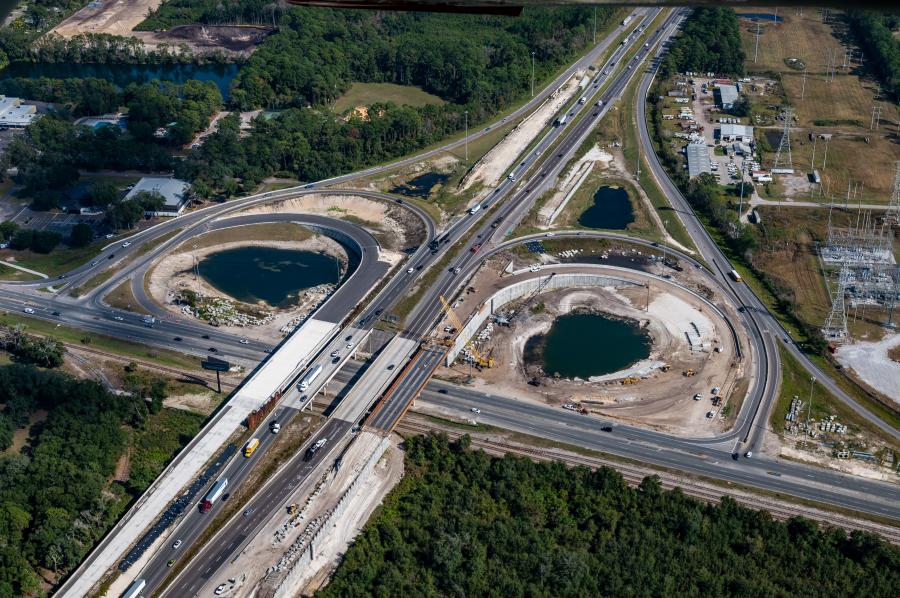The new construction will facilitate traffic for commuters as well as semis carrying goods from the Port of Jacksonville to railroad yards and local communities.
(FDOT photo)
A freeway upgrade in northeast Florida will make an impact on all manner of transportation, including the Port of Jacksonville, Jacksonville International Airport, railroad yards, commuters and tourists entering the state.
The I-95/I-295 project will modernize and reconfigure the interchange to improve traffic flow, safety and increase capacity. A collector distributor system will be a key part of the effort, which will enable motorists traveling I-295 to maneuver through the interchange with fewer lane shifts.
The project was let in 2016 to contractor Archer Western, with the expected completion for 2024. It is expected to cost $176.8 million. Multi-modal is a key principle for this transportation project.
"The Port of Jacksonville recently finalized operations to increase the depth of the channel to 47 feet, which means it can receive the larger container vessels from the Panama Canal," said Hampton Ray, community outreach manager of the Florida Department of Transportation (FDOT). "The work on I-295 means semis can carry loads from the port directly to railroads and industrial areas. Although the lanes are not just for truck traffic, it means a direct path for these vehicles and less changing lanes for car traffic. That adds up to safer travel."
The Port of Jacksonville is the 14th largest container port in the United States and the second largest handler of vehicles in the country. Some four million passengers traveled through Jacksonville Airport during the last fiscal year, an increase of 33 percent over last year. This activity means a lot of strain on the I-95/I-295 interchange.
A segment of the project will include auxiliary lanes and ramp improvements to I-95 and the Airport Road interchange. Workers will be building 13 new bridges.
FDOT planners also have included local residents in this complex endeavor. Workers will be building a shared-use path for walkers, joggers and bicyclists that will roughly parallel I-95.
"The entire northside of the city is growing rapidly," said Ray. "The capacity at the interchange is expected to double by 2024. With this new construction we should be ready to handle that."
The importance for this type of traffic planning was demonstrated when an Amazon fulfillment center and River City Marketplace retail mall opened. Both these high-traffic locations were born after the freeway upgrade had already begun.
Building in Florida carries its own special set of challenges.
"We have hurricane plans in place," said Ray. "We have had several major storms hit since the beginning of construction, but so far have not had any direct hits. We need to have our work not impede people who are fleeing from storms in other parts of the state."
Storms aren't the only problem. The water table is quite near the surface compared to what it is with road construction projects in other areas. So, planners and workers kept drainage issues in mind.
The contractor and workers have conducted a high-tech construction relay race for the new bridges.
"The work on these 13 bridges have required precise coordination," said Ray. "Often workers have installed massive bridge spans in the night and turned the roads over to active traffic underneath the next day."
Project designers managed to avoid the skyscraping flyovers.
"We changed the original design to shorter exits and merges," said Ray. "Those large flyovers can be intimidating to some drivers."
FDOT has established a strong partnership with CSX railroad and the contractor to ensure that the flow of freight would be affected as little as possible by the road work. The railroad tracks are parallel to U.S. 17, which travels north/south under I-295.
"With the railroad's assistance, existing bridges are being demolished and will be replaced by four new bridges that meet current FHWA and railroad standards," said Ray.
The project required specialized equipment to complete some steps of construction. One contractor brought in a jack and bore machine to install a 300-ft. section of 0.5-in. steel, 54-in. diameter drainage pipe.
The design-build team used shotcrete/gunite to add interior walls to strengthen 325 ft. of 12-ft. by 10-ft. double barrel box culvert.
Because of the size and complexity of the I-95/I-295 project, it required an extraordinary amount of material:
- 27,500 cu. yds. of concrete has been produced so far by an onsite batch plant. The project will require an estimated 82,000 cu. yds. for completion
- 123,000 tons of asphalt
- 24,000 tons of recycled asphalt — 20 percent of the mix design
- 2,000 tons of steel
- 2 million cu. yds. of soil moved or relocated to the site.
- 600,000 cu. yds. of soil imported.
The good news about this project is that it will have a positive impact on a multitude of transportation modes. The bad news is that it is extraordinarily complicated. The project requires three phases, 20 sub-phases and 125 traffic shifts to fully implement. Building the new bridges, ramps and newly configured lanes will happen while keeping the traffic flowing. Overhead signs are continually being updated so motorists can stay informed about how the traffic patterns will affect them.
"This project is less than 50 miles from the Georgia border and is an important highway corridor," said Ray. "Many people are coming to visit beaches and the theme parks. We want to make this entrance to the state as safe and uncomplicated as possible." CEG
Chuck MacDonald
Chuck MacDonald is an editor, blogger and freelance feature writer whose writing adventures have taken him to 48 states and 10 countries. He has been the editor for magazines on pavement construction, chemicals, insurance and missions. Chuck enjoys bicycling, kayaking and reading. He graduated from the University of Missouri with a degree in journalism. Chuck lives in Annapolis, Md. with his wife Kristen. They have seven grandchildren.
Read more from Chuck MacDonald here.
Today's top stories




















